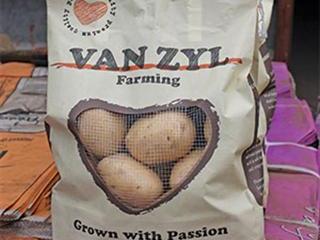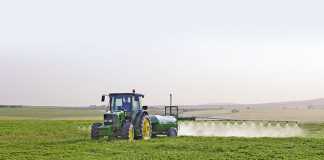
Johan van Zyl seems unaffected by the number of awards he has won for his potato farming skills and says that growing potatoes is reward enough. “I don’t go on holiday a lot because I like farming potatoes so much that work is like a holiday for me,” he jokes. “For Johan, it’s potatoes first then family!” adds his wife Lizelle. “The secret to his success lies in his passion for the crop.”
After farming with his father, Johan started farming independently in 1997. Today Van Zyl Boerdery in Warden operates on leased and owned land. He also plants maize and runs cattle, sheep and goats. Potatoes make up 90% of the farm income, while maize and livestock make up 5% each. Diversification improves cash flow stability and livestock can utilise the maize stover after harvest.
Reluctant to accept praise, Johan credits much of his success to the people he associates with. “But good planning and God’s grace are also important. You can do what you like on a farm but if there’s no rain, then that’s how it is. At the end of the day, God decides.”

Johan van Zyl
Rotating for A healthy crop
Johan plants his own potato trials on 30ha to test chemical applications, leaf nutrition requirements, fertilisers and cultivars. Although expensive, it is a necessary and valuable exercise, he maintains. Typically, potatoes are rotated on a land in a four-year cycle. After the potato season, maize is planted for two years. In year four, the land is rested and the soil grid-sampled and analysed. Nutrient imbalances are corrected and potatoes are planted again the following year.
Lands are sectioned into four units so that there is always one potato section, two maize sections and a fallow section. This rotation minimises the risk of soil-borne potato diseases. To alleviate weather risks, Johan spreads the planting, as much as possible, across the Warden area. “I lease lands up to 50km apart,” he explains. “Hail and rain tend to be localised; I’ve seen one of my lands completely destroyed by hail and the next one entirely unaffected.”
Cultivars
Johan buys his seed potatoes from First Potato Dynamics, Western Free State Seed Growers’ Association, and GWK. He plants Marquis, Up to Date, Mondial and Almera cultivars. Almera, a quick-growing cultivar planted in late August, boosts cash flow as it is harvested in January, a quiet time in the business. Mondial, Up to Date and Marquis are planted between September and October. Fertiliser is applied to seed according to requirements determined by soil analysis and trial results.
Johan explains that because fertiliser requirements vary from cultivar to cultivar trial results are crucial. After planting, Johan sprays herbicide to kill off weeds. Soil is ridged over the plant rows, more herbicide is sprayed and fertiliser is spread. A month later, lands are sprayed for fungi and insects. Chemical spraying continues, in 10-day cycles, until March, when the temperature begins to drop to the point where insect activity is suppressed. Chemicals are withdrawn three weeks before harvest.

After being bagged on the land, the potatoes are offloaded at the packhouse.
Johan uses Syngenta’s potato pack, which satisfies his crop protection requirements. A consultant inspects the crop every two weeks for pests and diseases. “I’m very grateful to my input suppliers because if they don’t perform, then I’m gone,” says Johan. He averages a yield of 28t/ha to 32t/ ha. With the exception of Almera, the potatoes are harvested between March and September as market demand dictates.
An on-site cold room
The Warden area is very cold in winter and the soil acts as effective cold storage. Potatoes can be left in the ground instead of being harvested and stored in a cold room. “It’s my cheap cold storage facility,” Johan quips. His workers count among his most important assets. “I have 300 seasonal workers and value them,” he says. “I’m worried about labour issues, but if everyone mechanises and workers are laid off, who will buy our produce?”
Local labourers from Warden harvest and pack the potatoes. Most have been working for him for years, some as long as a decade. About 20% of the harvest is grown on contract and supplied to McCain and Nature’s Choice. “I send the balance to market at the end of the month when consumers have more money,” Johan explains. “Demand is lower in the middle of the month because budgets are tight.”
He notes that while a higher price for potatoes would be welcome, it would also reduce demand. “It’s important to learn to ride the waves of the price fluctuations. When a cultivar is short on the market, I can deliver what’s needed because I have several cultivars in the soil.”
Making it profitable
Johan manages Van Zyl Boerdery with a carefully planned expansion strategy. “Ten years ago,” he recalls, “a speaker at a farmer’s information day said that to be sustainable, a farmer had to increase his turnover by 10% every year. I thought to myself, ‘this is impossible’. But I realised that I would stay behind if I didn’t grow. “Ten years ago, 20t/ ha of potatoes was a good harvest. Today one needs 28t/ha to break even. A packhouse costs millions to erect and it can’t be justified if you are a small potato farmer.”

Potatoes are bagged, ready to be marketed, in the packhouse.
Johan notes that a farmer reaches a stage when he can no longer grow horizontally, only vertically. “I would rather produce 5 000 bags of potatoes on 900ha than 6 000 bags of the same size on 2 000ha,” he says. He is concerned about the direction the potato market is taking. “Our industry is badly affected by cheap French fry imports. Many restaurants and takeaways that once bought fresh potatoes on the market now buy imported frozen chips. This obviously affects our farmers.
“Potatoes SA and the farmers need to focus on marketing. If the per capita consumption of potatoes can increase by 3kg per year, the price that the producer receives will improve drastically. “Almera, for example, is a low GI potato. But few consumers are aware of this because of a lack of marketing. There’s a huge opportunity to educate people on different cultivars. “In European supermarkets, they don’t simply sell ‘potatoes’. They market them according to the cultivar. This is the way to go here too.”
Johan plans to expand his enterprise, but only after considering market needs and establishing which cultivars are in demand. Despite the challenges, he remains positive about the potato industry because, as he says, “people must still eat”.
Contact Johan van Zyl at [email protected]












